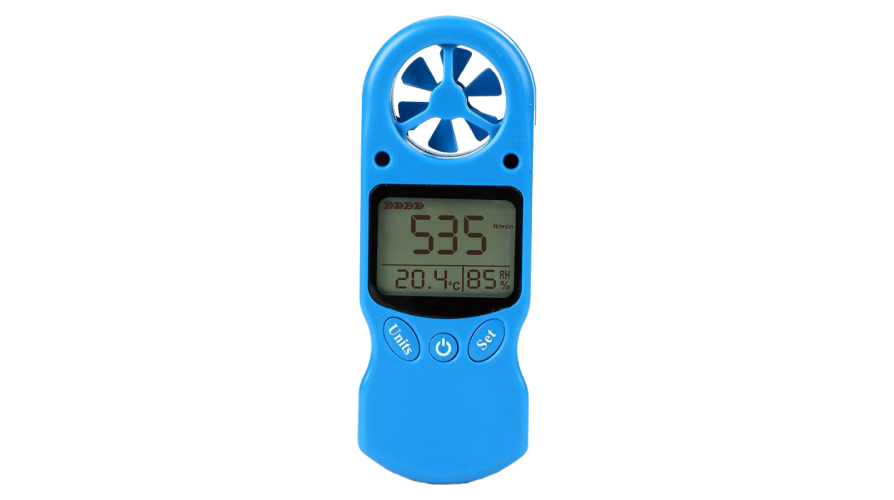Leading Attributes to Look for in an Effective Anemometer for Accurate Wind Measurement
Leading Attributes to Look for in an Effective Anemometer for Accurate Wind Measurement
Blog Article
All You Required to Understand About Anemometers: Exactly How They Function, Why They Matter, and Where to Use Them
Anemometers, though typically ignored in the world of clinical instruments, play an important duty in numerous areas, offering important insights right into wind rate and air movement patterns. As we delve into the complexities of anemometer innovation, we will certainly discover the internal functions of these gadgets, their relevance, and the vital factors to consider when picking the ideal anemometer for certain applications.

Anemometer Fundamentals
A crucial instrument made use of to determine wind speed and direction, the anemometer plays a crucial function in meteorology and different industries. An anemometer normally consists of three or 4 cups that turn in the wind, a vane that aims into the wind, and sensing units to track the activities or rotations.
There are numerous kinds of anemometers available, including cup anemometers, vane anemometers, hot-wire anemometers, and sonic anemometers, each with its special attributes and applications. Mug anemometers are commonly used for fundamental wind speed measurements, while vane anemometers are liked for directional dimensions.
Concepts of Anemometer Procedure
Structure on the fundamental understanding of anemometer essentials, the concepts of anemometer procedure clarify the technicians behind wind rate and direction measurements. Anemometers operate the principle of airflow affecting a sensing unit, triggering it to revolve. Mug anemometers, for example, have 3 or even more cups that capture the wind, causing them to spin faster as the wind rate rises. The turning speed is after that transformed right into a wind rate dimension. Vane anemometers, on the various other hand, utilize a tail or a probe that aligns itself with the wind direction, providing a measurement of wind instructions based upon the positioning of the sensor. Hot-wire anemometers depend on a heated wire that cools down as wind overlooks it, with the price of cooling identifying the wind speed. Ultrasonic anemometers measure wind rate and instructions by examining the time it takes for ultrasonic signals to take a trip in between transducers. Understanding these principles is crucial for accurate and trusted wind measurements in various applications.
Importance of Anemometers
The importance of anemometers in weather forecasting and various sectors can not be overstated. Anemometers play a critical function in measuring wind speed and instructions, giving important information for weather forecasting, environment studies, ecological monitoring, and aviation operations. Meteorologists count on anemometers to collect accurate wind information, aiding them comprehend climate patterns, predict tornados, and issue timely warnings to the public. In markets such as building, agriculture, sustainable power, and maritime procedures, anemometers are utilized to optimize processes, make certain safety, and increase effectiveness. Wind farm operators use anemometers to evaluate wind problems and optimize electrical energy production from wind turbines. In the maritime market, anemometers help ship navigating by supplying real-time wind details to captains, helping them make informed choices to guarantee risk-free trips. Generally, anemometers are essential devices that contribute significantly to safety and security, performance, and notified click here to read decision-making in weather forecasting and a wide variety of sectors.
Applications Across Numerous Industries
Applications of anemometers span across diverse industries, showcasing their versatility and utility beyond meteorology. In the renewable resource sector, anemometers play a crucial duty in examining wind problems for wind ranch positionings, guaranteeing ideal power production. Industries like construction and mining use anemometers to keep an eye on wind speeds, important for safety and security procedures, specifically when functioning at heights or in open-pit mines where solid winds can present dangers. Anemometers are additionally integral in the air travel sector, Homepage assisting pilots in understanding airspeed and wind direction for secure take-offs and touchdowns. The maritime sector gain from anemometers for ship navigation, assisting sailors prepare for weather changes and change courses appropriately. In agriculture, anemometers help farmers in taking care of plant splashing by providing real-time data on wind rate to avoid drift. Anemometers locate applications in A/c systems to enhance air movement and boost power effectiveness in structures. The diverse usage situations of anemometers underscore their relevance across numerous markets, highlighting their important function in enhancing operational safety and efficiency (anemometer).

Picking the Right Anemometer for Your Demands
Selecting the ideal anemometer customized to your specific requirements is important for getting accurate wind rate and direction measurements. When choosing an anemometer, think about factors such as the intended application, required measurement range, ecological problems, and desired functions. For basic purposes, a cup anemometer is suitable for gauging wind rate, while a vane anemometer gives wind direction information. Hot-wire anemometers are optimal for low airspeed measurements, and ultrasonic anemometers use high accuracy and longevity.

Verdict
Finally, anemometers play an important role in gauging wind speed and direction throughout various sectors. Comprehending the concepts of anemometer operation is essential for picking the best tool for details requirements. From meteorology to air travel, anemometers are vital devices for collecting exact data and making sure safety in various applications. It is very important to take into consideration the importance of anemometers in order to make enlightened decisions when picking the most appropriate tool for measuring wind problems.
There are numerous types of anemometers offered, consisting of mug anemometers, vane anemometers, hot-wire anemometers, and sonic anemometers, each with its unique functions and applications. Cup anemometers are frequently made use of for basic wind rate measurements, while vane anemometers are preferred for directional measurements. Hot-wire anemometers are suitable for low airspeeds, and sonic anemometers are optimal for high-precision dimensions in study and commercial setups.Structure on the fundamental understanding of anemometer essentials, the concepts of anemometer procedure illuminate the auto mechanics behind wind rate and instructions measurements. For general functions, a cup anemometer is suitable for measuring wind speed, while a vane anemometer provides wind instructions information.
Report this page